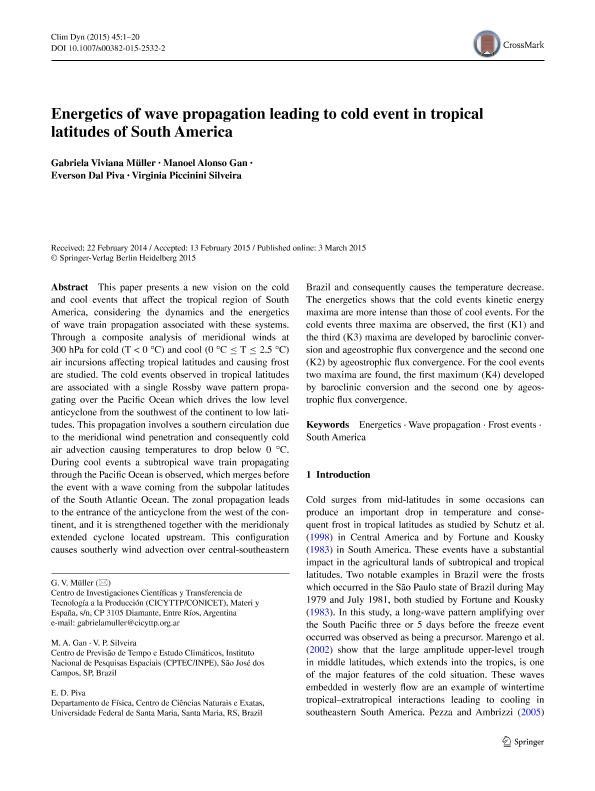Mostrar el registro sencillo del ítem
dc.contributor.author
Muller, Gabriela Viviana

dc.contributor.author
Gan, Manoel Alonso
dc.contributor.author
Piva, Everson Dal
dc.contributor.author
Silveira, Virginia Piccinini
dc.date.available
2018-02-27T19:46:08Z
dc.date.issued
2015-07
dc.identifier.citation
Muller, Gabriela Viviana; Gan, Manoel Alonso; Piva, Everson Dal; Silveira, Virginia Piccinini; Energetics of wave propagation leading to cold event in tropical latitudes of South America; Springer; Climate Dynamics; 45; 1-2; 7-2015; 1-20
dc.identifier.issn
0930-7575
dc.identifier.uri
http://hdl.handle.net/11336/37314
dc.description.abstract
This paper presents a new vision on the cold and cool events that affect the tropical region of South America, considering the dynamics and the energetics of wave train propagation associated with these systems. Through a composite analysis of meridional winds at 300 hPa for cold (T < 0 °C) and cool (0 °C ≤ T ≤ 2.5 °C) air incursions affecting tropical latitudes and causing frost are studied. The cold events observed in tropical latitudes are associated with a single Rossby wave pattern propagating over the Pacific Ocean which drives the low level anticyclone from the southwest of the continent to low latitudes. This propagation involves a southern circulation due to the meridional wind penetration and consequently cold air advection causing temperatures to drop below 0 °C. During cool events a subtropical wave train propagating through the Pacific Ocean is observed, which merges before the event with a wave coming from the subpolar latitudes of the South Atlantic Ocean. The zonal propagation leads to the entrance of the anticyclone from the west of the continent, and it is strengthened together with the meridionaly extended cyclone located upstream. This configuration causes southerly wind advection over central-southeastern Brazil and consequently causes the temperature decrease. The energetics shows that the cold events kinetic energy maxima are more intense than those of cool events. For the cold events three maxima are observed, the first (K1) and the third (K3) maxima are developed by baroclinic conversion and ageostrophic flux convergence and the second one (K2) by ageostrophic flux convergence. For the cool events two maxima are found, the first maximum (K4) developed by baroclinic conversion and the second one by ageostrophic flux convergence.
dc.format
application/pdf
dc.language.iso
eng
dc.publisher
Springer

dc.rights
info:eu-repo/semantics/openAccess
dc.rights.uri
https://creativecommons.org/licenses/by-nc-sa/2.5/ar/
dc.subject
Energetics
dc.subject
Frost Events
dc.subject
South America
dc.subject
Wave Propagation
dc.subject.classification
Meteorología y Ciencias Atmosféricas

dc.subject.classification
Ciencias de la Tierra y relacionadas con el Medio Ambiente

dc.subject.classification
CIENCIAS NATURALES Y EXACTAS

dc.title
Energetics of wave propagation leading to cold event in tropical latitudes of South America
dc.type
info:eu-repo/semantics/article
dc.type
info:ar-repo/semantics/artículo
dc.type
info:eu-repo/semantics/publishedVersion
dc.date.updated
2018-02-27T14:17:43Z
dc.journal.volume
45
dc.journal.number
1-2
dc.journal.pagination
1-20
dc.journal.pais
Alemania

dc.journal.ciudad
Berlin
dc.description.fil
Fil: Muller, Gabriela Viviana. Provincia de Entre Ríos. Centro de Investigaciones Científicas y Transferencia de Tecnología a la Producción. Universidad Autónoma de Entre Ríos. Centro de Investigaciones Científicas y Transferencia de Tecnología a la Producción. Consejo Nacional de Investigaciones Científicas y Técnicas. Centro Científico Tecnológico Conicet - Santa Fe. Centro de Investigaciones Científicas y Transferencia de Tecnología a la Producción; Argentina
dc.description.fil
Fil: Gan, Manoel Alonso. Centro de Previsao de Tempo e Estudos Climáticos. Instituto Nacional de Pesquisas Espaciais; Brasil
dc.description.fil
Fil: Piva, Everson Dal. Universidade Federal de Santa Maria; Brasil
dc.description.fil
Fil: Silveira, Virginia Piccinini. Centro de Previsao de Tempo e Estudos Climáticos. Instituto Nacional de Pesquisas Espaciais; Brasil
dc.journal.title
Climate Dynamics

dc.relation.alternativeid
info:eu-repo/semantics/altIdentifier/doi/http://dx.doi.org/10.1007/s00382-015-2532-2
dc.relation.alternativeid
info:eu-repo/semantics/altIdentifier/url/https://link.springer.com/article/10.1007%2Fs00382-015-2532-2
Archivos asociados
